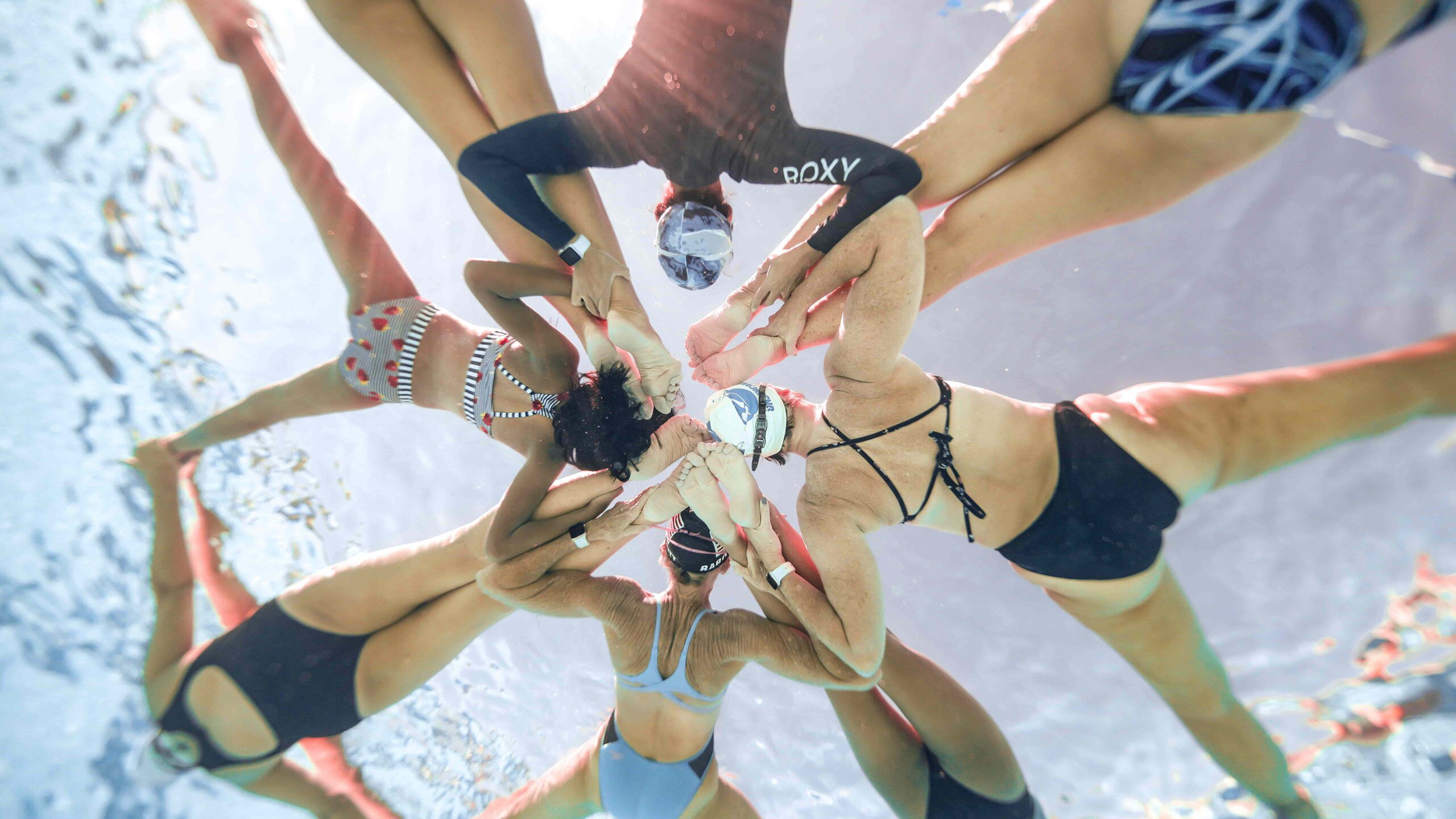When we first meet Cris Meier-Windes in the uplifting 2023 documentary Unsyncable, he is under the bright California sun with a pair of sunglasses on, swaying and flapping his arms in what looks like dance practice, except this isn’t a dance routine made for land. “You Are Always on My Mind” by the Pet Shop Boys blares in the background and we see Meier-Windes shimmying around, counting and enjoying the beat of the music as much as the movement. Synchronized swimming “hooks you with the music and the emotion. Even before the athletics start,” he says.
At 68 years old, the boyish and sprightly Meier-Windes is one of the younger athletes featured in Unsyncable’s cast of endearing characters. Meier-Windes is a member of the San Francisco Tsunami Aquatics, a LGBTQ2S+ masters-level aquatic club with swim and synchronized-swimming teams. His partner, Rick, who was also a longtime swimmer, co-founded the club in 1986.
Unsyncable also features “synchro legend,” Sue Baross Nesbitt, also 68, who has been performing for decades and swims with the Unsyncables of La Mirada team; rookie Ellen Scott (62), the lone Canadian in the documentary, whose infectious enthusiasm can barely be contained; the stylish former marine and lifelong athlete, Luther Gales (82) and his teammates Monica Hale (68) and Joyce Clarke (71) of the Harlem Honeys and Bears (North America’s only all-Black artistic swimming team since 1979).
Nova Scotia–based filmmaker Megan Wennberg began the project in the early days of the pandemic, and over the course of two years, went from online interviews to following the athletes into the pool and filming underwater as they trained and prepared for the 2021 USA Artistic Swimming U.S. Masters Championship in Maine.
The athletes’ dedication to the sport is evident throughout the documentary. They all come from different backgrounds, some of them swimming competitively since childhood, while others found the sport later on in their 50s and 60s after suffering heartbreak or facing a health scare. Whatever their reasons for diving in, what unites them is their pure love for the sport. They live and breathe artistic swimming (formerly known as synchronized swimming, it was officially renamed artistic swimming in 2017). In several scenes, we see the athletes practising land drills, an out-of-water activity that allows synchronized swimmers time to fine-tune their routines out of the pool. Despite the glitz and glam of the costumes and music, artistic swimming is a physically demanding activity requiring strength, speed, agility and impressive lung capacity. Not to mention the ability to memorize routines and stay on beat, it’s no wonder the athletes are drawn to the full-body and mental workout.
Wennberg, whose previous award-winning projects include Drag Kids (2019) and The Killing of Phillip Boudreau (2021) says she was drawn to the seniors’ positive attitudes and outlooks on life. “The message that I got from all of the athletes was just really about doing whatever you can to live your best life as long as possible,” she tells Xtra.
In the film, Meier-Windes says artistic swimming saved his life. A lifelong athlete, Meier-Windes started off as a competitive sprint swimmer, but turned to artistic swimming after Rick, a competitive distance swimmer and stalwart in the U.S. Masters swimming, passed away in 2004.
“When you meet the love of your life, you want it to go on forever, but there is no ‘forever’ in anybody’s situation,” Meier-Windes says in the film. He eventually returned to the pool in 2005 to try another kind of swimming. “I gave up racing, but at the same time, I picked up synchro. It gave me a new challenge that wasn’t connected to Rick. He wasn’t in the next lane over, and it was just so painful, so synchro helped a lot,” Meier-Windes tells Xtra. Through artistic swimming, Meier-Windes was able to form a different family with his Tsunami teammates and community.
There is a scene in Unsyncable, where Meier-Windes walks the viewer through his hallway in his house, showing off various medals collected over the years from his swimming career, including ones from the Gay Games, in which both he and Rick participated. The Gay Games, an international queer and trans sporting event, began in 1982 and was known as the Gay Olympics. Meir-Windes’s medals from the inaugural year have the word “Olympics” scratched off of them because the U.S. Olympic Committee, concerned with protecting the Olympics brand, threatened the Gay Olympics with a lawsuit, forcing a name change three weeks before the debut event in San Francisco. Despite the bumpy start, the first games went off without a hitch, welcoming 170 competitors from around the world, with Tina Turner performing at the opening ceremony.
Artistic swimming has been making some big splashes in the past few decades. The Paris 2024 Olympics will be the first time men will be eligible to compete in the team event. Previously men were allowed to compete in the mixed duet event only.
“I’ve been waiting 19 years for this to happen,” says Meier-Windes. “Now they have a men’s category, a women’s category and [an] open category so that anyone can participate. That’s been a long time coming.”
Unsyncable culminates at a national competition in Maine. Though often competing, everyone featured in the documentary remains supportive of. We see characters fawn over each other and joke around on deck. The characters are as much buoyed by their teammates as they are by their competitors as they cheer each other on.
What really makes this playful film memorable are the characters, each one of them exuding a youthful vitality. The film is a testament to the power of the body, but more importantly, the human spirit. Despite the fact that the storyline hinges on the athletes’ ages, Unsyncable celebrates the present and the joy and connections that can be found in the pool.
“Sports are just an outlet, but if you connect with the people, it becomes bigger than that,” says Meier-Windes with a wide smile.
Unsyncable is making its world premiere at this year’s Hot Docs festival in Toronto on May 3 and 5.


 Why you can trust Xtra
Why you can trust Xtra


